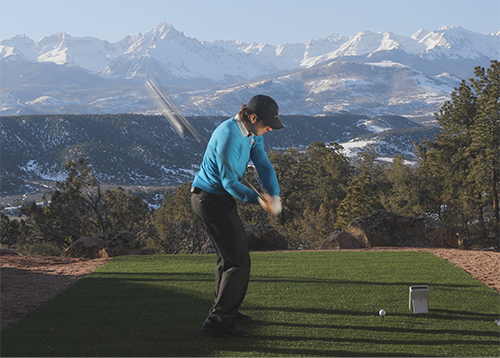Rickie Fowler - How to preserve Lag
Rickie Fowler - How to preserve Lag
Description
Lag is the most efficient way to increase clubhead speed. In this video, RST Instructor Chris Tyler shows you how to slowly develop lag into your swing and how to preserve it properly in the downswing.

We're going to be focusing in on the 2016 Abu Dhabi champion Rickie Fowler who just moved himself with this victory into the number four position in the world golf rankings. That's the first time we've seen Rickie move inside the top five, so congratulations to him for that feat.
We're going to be focusing in on lag and the importance of it in the golf swing. If you've been looking for a solution or a way to start to create more lag in your golf swing so that you can accelerate the golf club the most efficient way possible, you're going to want to pay close attention to today's review. Let's go ahead and get started.
All right guys, so as I said in the opener, we're going to be focusing in on lag this week. Lag is obviously a very very simple way to give yourself a good boost in club head speed. It's a very efficient way to give yourself that boost. We're going to be talking about two really key components to this whole process. Number one we're going to be talking about how to create lag slowly in your golf swing. Number two, the most common area for amateur golfers that they struggle with is the preservation of lag, so we're going to talk about down swing sequencing and how to preserve lag so that you can start to ramp your club head speed up quite a bit.
I encourage you, if you don't have a lot of the stuff in place that we talk about in part one of this video, that you pump the brakes and say okay I'm going to take full commitment to getting these things down, and you'll see that lag becomes very very easy to attain by doing things properly early on in the golf swing.
All right guys, so let's not waste any time. Let's get right into section one of this video and talk about the slow development process of lag and a couple of check points that you're going to be looking for with your own golf swing. Let's go ahead and get into a take away position. Talk about the importance of establishing width and rotation. So, into a good golf takeaway position. You're going to see most tour players look very similar to what Rickie does here. You're going to see a club shaft that's parallel to the ground. You're going to see that we've rotated our body about 45 degrees, and you're going to see that we've shifted about 80 to 85% of our weight into that trail leg.
Now, what have we done with the arms at this particular junction of the golf swing? Well, we haven't really done a whole lot. Yeah, they may be elevated just a little bit, and they may be rotated just a fraction, but really the body is doing a lot of the heavy lifting. This is where a lot of amateur golfers tend to struggle with it because what the tend to do is to move this club off the golf ball, we can move it pretty quickly with just our wrists and our trail arm. If you start from this particular junction of the swing and you've flexed your right arm, and you cocked your wrists and rotated them a little bit, you could see that you could move that golf club a good six to eight to 10 feet without even having to turn your body or even shirt your weight.
Now, what's the problem with that? Number one, that's actually signaling to your brain that your hands and arms are now becoming your primary power source. Number two, if you start to load a muscle group up, ie the wrists here. If you start to load your wrists up, and they're getting to that full contraction point, then they're going to want to turn and fire and go in the other direction. That's when we start to see amateur golfers tend to throw the club too early, start to burn up all that lag, and then they run out of speed down at the bottom of the arc. A good check point for you in the take away is to make sure that your arms have done very little. You want to make sure that you've established width by shifting your weight and rotating your body.
Now the second check point to help slow develop lag into your swing is going to be this particular position I'm going to show you now. This is when the hands get to about the center of the chest or sternum height here. You can see that the hands are right around the center of the chest. Now notice the position of the club shaft. You can see that it's gone to a more vertical position now. Where it was parallel to the ground when the hands were at about pocket height, now the hands have worked up just a slight amount here. We continue to rotate our body, and we've slowly started to see that angle increase.
We don't want to have this angle fully maxed out at this particular junction of the swing because we still have more rotation available to us. We still have more width available to us because we're going to continue to move our hands and arms further into the golf swing. Your next check point here is as you slowly start to rotate and your hands get up at about the center of your chest is you want to make sure your club shaft is about a vertical position just like you see here on the screen. Then we're going to continue to rotate our body. That angle's going to increase. You can see the hands are still lifting here. Makes a good, wide, full turn. Now we're going to talk about the preservation process of lag. You can see that we've made a good giant full turn with the upper body. We've shifted our weight. We've created some good separation between the shoulder line and the hip line. Now we're going to talk about how to get this golf club moving on the way down without doing much with your hands and arms just like you did on the way up.
Okay guys, so now that we've talked a little bit about the slow development of lag into the take away and back swing, and I've given you a couple of check points to look for, what we really want to focus on in the preservation process is just doing very little with the wrists, the forearms, the arms and the shoulders on the way down. We want to allow your lower body to do all the heavy lifting. If you were to focus on shifting and unloading your lower half like you're going to see Rickie do here. You're going to see a good move from his lead side, starting to pull from his left leg here. He's getting seated into that left leg with lots of his weight shifting over into that side.
Now if you notice here, the hands have come down from the top of the back swing here, so the shoulders and the hands and arms are being pulled down into this position and notice that the angle that the club shaft is on now that the hands are in the center of the chest. As you can see hands are right in the center of the chest, and as we were looking at it, when we were starting to work from a take away into the back swing, the club shaft was in a vertical position. This is where the angle has been able to be increased, and then we're preserving it on the way down by using the lower half. This is where a lot of amateur golfers, like I said, tend to struggle is that we want to use the right side of the body to push against the club, and in turn that causes us to burn up this angle. We won't have it to use for leverage at the bottom of the swing arc.
As we continue to allow the lower body to do a lot of the heavy lifting, a little bit of gravity's help pulling the arms down here as well. Now we are in that release point of the swing to where we can start to fire this angle. Hands are approaching in front of the trail thigh. You can see the club shaft is back to a parallel position, and now we can really start to unload this angle and start to extend through the hitting area, widen the swing arc back up and be at max speed down here at the bottom of the swing arc.
As far as the preservation process is concerned, you want to make sure that your arms are being very, very passive. Allow your lower body to really get unloaded. Once you feel that weight get over into your left side, just like Rickie's doing right here, then it's a matter of you starting to post this up and then start to clear your hips. That's going to move your arms even further down, and then you're going to start to release the golf club, and you'll have tons of speed.
All right, so game plan for you guys that have been struggling with these areas of the golf swings. I got a couple of videos. Actually I got three videos that I want you to check out this week. Number one is the wide, narrow, wide swing shape. Wide, narrow, wide swing shape's going to talk to you about getting width early on in the swing. It's going to talk to you about the importance of narrowing the swing arc from the top of the swing down, and how to get a good wide extension like you're seeing on your screen now.
Then the keep the right arm straight to turn video. If you've been having a hard time, and you notice that your right arm folds up really early in your take away or your back swing. You notice that you're not making a good full turn. This video's going to save your life with that particular aspect of the swing. It's going to save your golfing life. I promise you.
Then the final video is a video that was one of our member's favorites, how to swing from the ground up. It's a great video that gave you a good drill on how to use your lower body, and so that you can sequence your down swing properly and you can start to preserve lag just like you saw Rickie do here. All right guys, so slowly develop lag. Preserve it. Release it, and you're going to have tons of club head speed this year. Let's get out there and play some great golf.
Testimonials

-Dr. Jeffrey Broker, Assoc. Prof. in Biomechanics at University of Colorado at Colorado Springs and Former Senior Biomechanist for U.S. Olympics Committee

-Hub Orr - Happy PREMIUM MEMBER of RotarySwing.com

-Sam Jarman, PGA Golf Instructor in the UK

Build the perfect golf swing following the most advanced online golf swing learning system!
JOIN OUR 445,147 MEMBERS AND GET INSTANT FREE ACCESS TO DOZENS OF VIDEOS!



